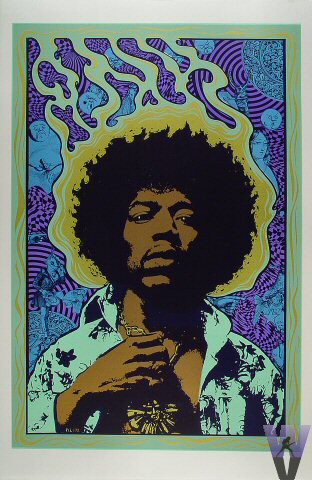Archive for the ‘rock’ Category
otis redding ( 1966 )
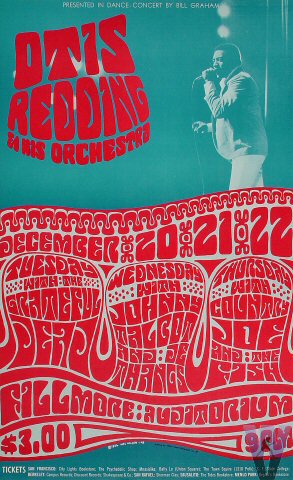
In December of 1966, Janis saw Otis Redding perform for the first time. She attended every performance that he gave that weekend at the Fillmore. An hour before the show, she’d be on the dance floor and would place herself in the middle, very close to the stage. While he sang, she watched, transfixed. She absorbed his motions, dwelled on his shouts, and in her imagination perhaps could hear her own voice in those corrugated rasps.
Bron: otisredding.com
jefferson airplane
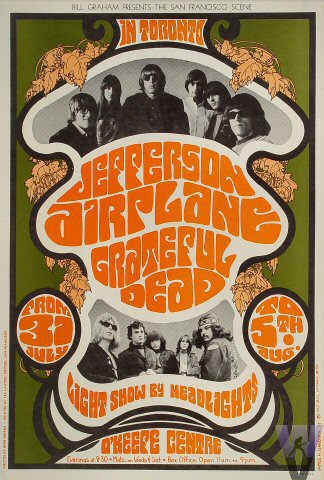
Jefferson Airplane’s debut show was on August 13, 1965 at the Matrix nightclub in San Francisco. The first performance featured Marty Balin on vocals, Paul Kantner on vocals/rhythm guitar, and Jorma Kaukonen on lead guitar. Signe Anderson, (who sang on Jefferson Airplane’s first recording “Jefferson Airplane Takes Off”) also performed. The bass player, Jack Casady and drummer Skip Spence, (who was later one of the original members of Moby Grape) joined the band two months later. Spencer Dryden became the drummer in June of 1966 and Grace Slick joined as vocalist in October of 1966. The band performed the first concert for Bill Graham at the legendary Fillmore Auditorium in San Francisco in February of 1966.
Jefferson Airplane performed at the Berkeley Folk Festival, Monterey Jazz Festival, Monterey Pop Festival, Woodstock, and Altamont. They had hit singles White Rabbit and Somebody to Love, from the album “Surrealistic Pillow”. They were on the cover of Life Magazine in 1968. The band co- headlined with the Doors in Europe in the summer of 1968. Many legendary bands opened for the Airplane: Grateful Dead, Santana, The Doors, Jimi Hendrix, Creedence Clearwater Revival, The Who, Janis Joplin, Steve Miller, and many others.
Bron: jeffersonairplane.com
fillmore auditorium
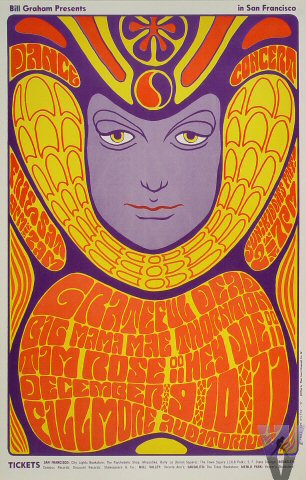
“The greatest compliment I was ever given came at The Fillmore. It was Cream and the Butterfield Blues Band. I just happened to go into the rest room during a break. I was standing at the middle urinal when two guys came in after me, one on either side…right out of the blue, one said, ‘I forgot. Who’s playing here tonight?’ Without batting an eyelash, the other guy said, ‘I don’t know, man. What’s the difference? It’s The Fillmore.” -Bill Graham
Bron: thefillmore.com
the byrds

The Byrds were the first American supergroup. The combination of Roger McGuinn’s ringing 12-string Rickenbacker guitar, Gene Clark’s poetry, David Crosby’s harmonies, Chris Hillman’s bluegrass-influenced bass playing and Michael Clarke’s enthusiastic drumming ushered in a new era of Rock ‘n’ Roll. A music that changed the way we felt and thought and looked at ourselves and each other.
grateful dead in the fillmore
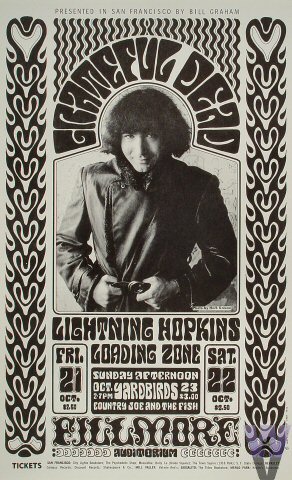
“The greatest compliment I was ever given came at The Fillmore. It was Cream and the Butterfield Blues Band. I just happened to go into the rest room during a break. I was standing at the middle urinal when two guys came in after me, one on either side…right out of the blue, one said, ‘I forgot. Who’s playing here tonight?’ Without batting an eyelash, the other guy said, ‘I don’t know, man. What’s the difference? It’s The Fillmore.” -Bill Graham
Bron: thefillmore.com
buffalo springfield

During its brief and stormy lifetime, Buffalo Springfield broke ground for what became country rock. In March of 1967, Buffalo Springfield went Top Ten with “For What It’s Worth,” written after the Sunset Strip riots. The group then began to disintegrate, recording its second album on the run. Recording in Los Angeles allowed them to work with some of the best available musicians from the area, such as Jim Messina. Neil Young was ambivalent to the group’s fame and eventually left the group to record on his own. Stephen Stills also left to form Crosby, Stills, and Nash, with David Crosby from the Byrds and Graham Nash from the Hollies.
